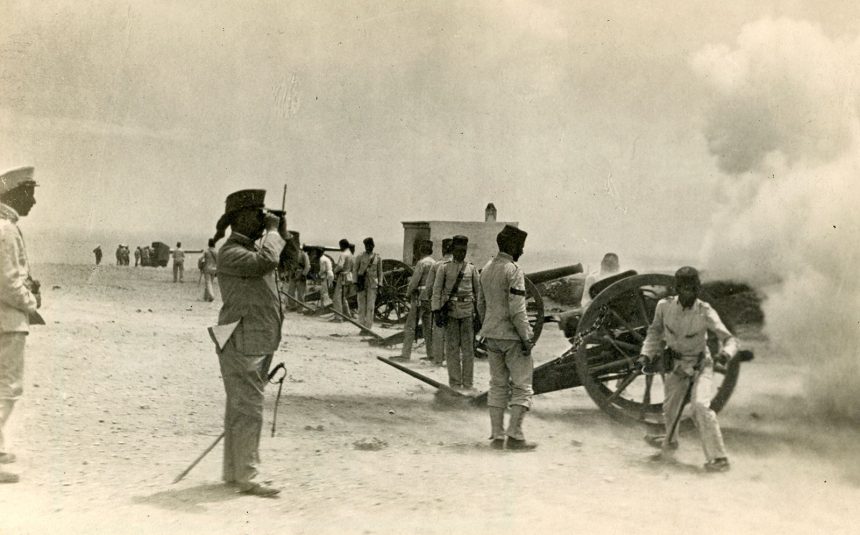The Rif War between 1921 and 1926 was a succession of armed conflicts. It pitted the Spanish and then French colonial powers against the Riffian Republic, led by Abdelkrim el-Khattabi. The Rif War was known to be particularly violent, marking the history of anti-colonialism and the construction of Morocco as a nation. This conflict, considered a transition between World War I and World War II, resulted in tens of thousands of casualties, both on the Spanish and French sides, as well as on the side of the Rif Republic, a coalition of Berber tribes.
What Are the Causes of the Rif War?
We must trace the origins of the Rif War back to the 19th century, when the French and Spanish conquered the territory. On March 30, 1912, the Treaty of Fez established the French protectorate over Moroccan territory. France and Spain concluded the Madrid Convention in November of the same year. The Madrid Convention established three Spanish zones of influence: Tangier and the Rif, Ifni, and the Tarfaya region.
While France and Spain exploited their territories, the Riffian tribes carried out demonstrations of force and tried to preserve their culture. Isolated conflicts arose, evolving into confrontations and ultimately into guerrilla warfare. The war started in the Rif region of the Spanish protectorate’s northern zone. This territory corresponds to the Mediterranean border, in the northern part of the country.
How Did the Rif War Unfold?
The Rif War took place from 1921 to 1926, with Spanish participation from 1921 to 1925 and French participation from 1925 to 1926, in the Rif region of Morocco. In 1921, Mohamed Abdelkrim el-Khattabi (known as Abd el-Krim) wanted to unify the Riffian tribes to organize the Rif liberation army and emancipate themselves from Spain and France. The Battle of Annual marks the beginning of the Rif War; it took place during the summer of that same year. On the Spanish side, Manuel Fernandez Silvestre had 60,000 soldiers. He was preparing to face the Beni Ouriaghel tribe and its allies.
After suffering a defeat and losing 12,000 men, the Spanish general committed suicide.
Abd el-Krim founded the Republic of the Rif. Abd el-Krim established the Rif Republic’s government and outlawed tribal conflicts. In total, 20,000 to 30,000 men joined the military formations. In 1924, Spanish troops had to withdraw along the coast. In 1925, Abd el-Krim launched a surprise attack on the French zone.
As the French and British feared for their colonial project, they intervened alongside Spain. The Rhine Army sent troops, tanks, planes, and heavy artillery. In September 1925, the Spanish landing at Al Hoceima took place, the first amphibious air-naval operation in history. They pushed back the Riffian tribes and defeated Abd el-Krim. His surrender took place on May 30, 1926.
Why Did the French and British Intervene?
The French and British decided to fight alongside Spain in 1925. Marshal Lyautey had first provoked the hostility of local tribes by peacefully occupying the Rif Valley. He refused to negotiate an agreement with the Riffians, believing that only the Sultan of Morocco was sovereign.
Abd el-Krim feels betrayed, and Lyautey, acting on behalf of the Sultan, wants to preserve the French colonial empire’s integrity. Abd el-Krim launches an offensive on April 13, 1925. French posts are surrounded one after another. Paris strongly questions Lyautey’s strategy, while Riffian troops fail during an offensive near Fez in the spring of 1925.
Who Are the Protagonists of the Rif War?
Units of the Army of Africa initially led the French troops. Metropolitan reinforcements then arrived on site: in August and September 1925, more than 150,000 French soldiers were distributed among the various sectors of the Rif. Among the best-known generals were Pruneau (western sector), Marty (central sector), and Boichut (eastern sector). Marshal Lyautey, who resided in Rabat, resigned in September 1925; he was replaced by Marshal Pétain at the head of French troops. General Primo de Rivera commanded the Spanish troops. What about the Riffian tribes? Their leader was Abdelkrim el-Khattabi, known for his fight against the colonizers of Morocco. In 1919, he had begun to unite the Rif tribes in an independent republic. The whole point was to overcome enmities and create a powerful tribe capable of repelling French and Moroccan colonial troops.
Were Chemical Weapons Used During the Rif War?
On the Spanish side, Hidalgo de Cisneros, an aviation general, dropped a 100-kg mustard gas bomb from his Farman F60 Goliath during the summer of 1924. This chemical weapon had been manufactured in Madrid by Hugo Stoltzenberg, a German chemist. This dropping took place a year before the signing of the Geneva Protocol, which aims to prohibit the use of “asphyxiating, poisonous, or similar gases and bacteriological means.” The Spanish army had kept these bombings hidden. However, several witnesses mentioned using these toxic gases in their autobiographies. In 1990, two German journalists and investigators managed to prove the veracity of the chemical attacks using scientific methods. The objective was to target heavily populated territories to cause maximum damage. The Treaty of Versailles in 1919 had forbidden Stoltzenberg from producing mustard gas.
How Many Deaths Were There During the Rif War?
More than 27,000 casualties were recorded among Spanish troops (dead and wounded) and more than 18,500 among French troops (2,500 soldiers died in combat, 7,500 died of disease, and 8,500 were wounded). As for the Riffians, more than 10,000 men perished on the battlefield. The number of casualties is also high among Riffian civilians due to the use of chemical weapons. Estimates place the Rif War’s death toll between 45,000 and 70,000.
What Are the Consequences of the Rif War?
French troops supported Spanish troops to preserve the Moroccan protectorate and subject local tribes to the authority of Moulay Youssef. The latter reigned over Morocco from 1912 to 1927 as Sultan. The Rif War marked the end of the Republic of the Rif and the exile of Abdelkrim el-Khattabi. The former leader of the Riffian tribes complained about the use of mustard gas to the League of Nations. Another consequence of the Rif War was the emergence of aviation.
Among the many reinforcements arriving from the mainland were French military pilots, who managed to play a key role in operations, particularly reconnaissance. They supported the army until the Riffian tribes were defeated. The Battle of Ouergha, a confrontation that took place between April and July 1925, marked the end of Marshal Lyautey’s sovereignty over Morocco. While the French army had sufficient means to win, it lost this battle. Marshal Pétain replaced Hubert Lyautey.
The latter led a victorious campaign in the Rif region. Francisco Franco was another general who emerged during the Rif War. The Spanish military and statemen showed leadership and tactical qualities during the war. He trained the newly created units of the Spanish Foreign Legion. France and Spain dissolved the Republic of the Rif, but the Moroccan protectorate persisted until 1956.




